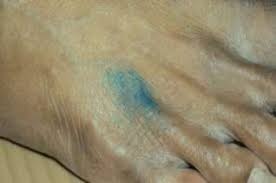
Shia is a 32-year-old receptionist who presents with blue discolouration affecting her feet and causing staining on the inside of her shoes for the past month.
She has noted similar staining on her bedsheets. This has been most marked on hot days.
Shia is otherwise well, takes no medications, and has no known allergies.
The only change to skin care or laundry products recently was the introduction of a purple shampoo three months ago to stop her existing blond highlights from turning brassy.
On examination blue-purple discolouration affecting the feet (pictured) is noted, which comes off when rubbed with an isopropyl alcohol wipe.
There are no other findings of note.
What is the most likely diagnosis?
Correct!
Chromhidrosis is a rare dermatological condition typified by passing coloured sweat from apocrine or eccrine sweat glands.
Eccrine glands are primarily responsible for thermoregulation, and are widely distributed on the body with the highest concentration on the palms and soles.
Apocrine glands mature after puberty and are most densely distributed in the axillae, anogenital areas, and areolae.
Eccrine chromhidrosis may present at any age and have multiple causes. Lipofuscin granule secretion may be a factor.
Lipofuscin is a yellowish pigment thought to be produced by the oxidation of unsaturated fatty acids.
In addition, sweat may be coloured by the excretion of water-soluble exogenous agents such as dyes, medications or heavy metals.
Potential causative agents include tartrazine-coated bisacodyl, quinine, rifampicin, silver, mercury, copper, ammonium, betacarotene, and dyes such as methylene blue, fluorescein, and dyes in cranberry juice.
In this case, the causative agent is thought to be one of the dyes in the purple shampoo.
Hyperbilirubinaemia and uraemic frost (a rare complication of renal failure) are rare causes of eccrine chromhidrosis.
Apocrine chromhidrosis is the more common form, typically presenting after puberty. It is most often due to lipofuscin granule secretion, with no clear aetiology.
The colour of secreted sweat is determined by the oxidation state of the lipofuscin granules; sweat can be black, brown, blue, green, yellow or pink.
The greater the oxidation, the darker the colour appears.
Patients with chromhidrosis typically complain of staining of clothing by sweat. Dried, coloured sweat or skin staining may be visible in the affected area.
Sweat excretion may be preceded by a feeling of warmth or skin prickling. Stimuli that elicit sweating usually exacerbate the findings.
The diagnosis is usually clinical. Diagnostic aids may include Wood’s lamp examination (which may show yellow fluorescence in apocrine chromhidrosis), skin biopsy (to distinguish eccrine from apocrine chromhidrosis) and skin scraping and culture to identify chromogenic organisms (a cause of pseudochromhidrosis).
Treatment is withdrawal of the offending agent, which typically results in resolution of discolouration.
Alkaptonuria is an uncommon autosomal recessive disorder caused by deficient activity of homogentisic acid dioxygenase, which causes brown discolouration of axillary and inguinal skin, and brown-blue pigmentation of the ear cartilage and sclera, which may be mistaken for chromhidrosis.
Haematidrosis is a rare condition characterised by the secretion of blood from intact skin, often in association with bleeding disorders, extreme stress or fear.
Cutaneous hyperpigmentation secondary to deposition of endogenous or exogenous pigments in the skin is not associated with worsening with sweating, transmission of pigment to clothing or removability with an alcohol swab.
